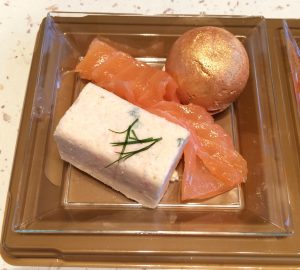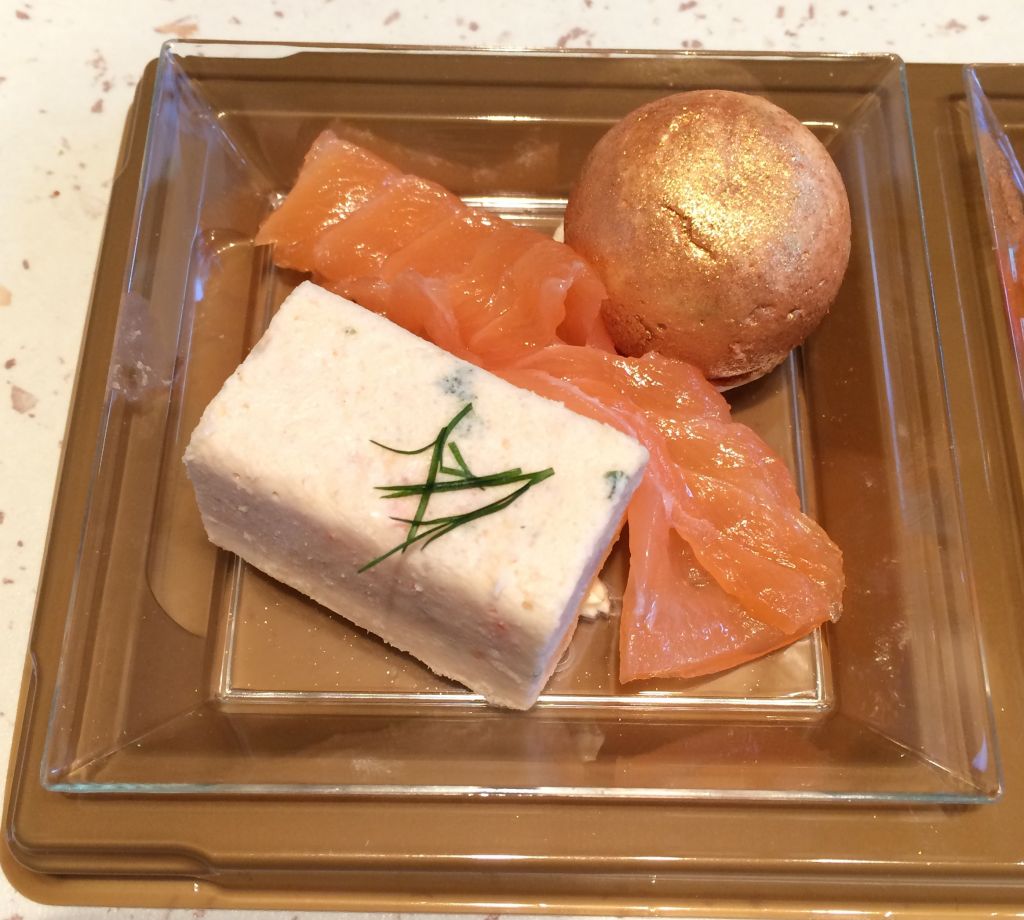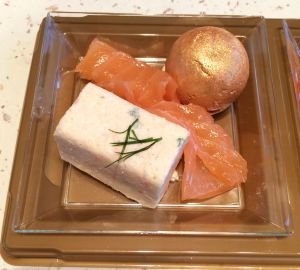A tale of two cities: Actually, more a tale of two countries! Undercurrent News reported that in the run up to Christmas, Scottish salmon prices had gone crazy. Prices for large fish reached a staggering £9/kg.
By comparison, we recently suggested that we would be able to buy whole Scottish salmon at retail for just £4/kg. It wasn’t a difficult prediction to make given that Lidl, the store concerned, had quoted the price in their Christmas brochure.
However, Lidl, were not the only retail store selling whole salmon at prices well below £9/kg, although we should point out that not all of it was of Scottish origin.
This Christmas, whole salmon prices at British retail were:
Lidl – £4/kg
Tesco – £4.50/kg
Asda- £5/kg
Morrison’s – £5.82/kg
Sainsbury’s – £6/kg
Compared to twenty years ago, fresh whole salmon is no longer a major seller at Christmas but stores continue to promote it as a key Christmas offering. In fact, raw salmon has now taken a back seat with the focus on added value products made from smoked salmon. Even though salmon prices are high, there is still a wide range of added value products available. Some are quite complex and involve several different elements. They are a far cry from a pack of smoked salmon.

Smoked salmon is still popular but some retailers have resorted to promotional discounting to attract customers with prices cut by up to a third.
What was different in the UK this year to previous years was the late arrival of many Christmas offering into store. In past years, Christmas salmon products have been available through much of December, probably in the expectation that they would be bought for pre-Christmas parties. This year, many offerings didn’t appear in store until the last few days before Christmas which might have had something to do with minimising wastage because of the high raw material prices.
We weren’t in France during the week running up to Christmas so it is possible that France too saw a last-minute rush for salmon. However, what we saw, did not fill us with too much hope. The availability of fresh salmon was low. Stores, which in years gone by have had large numbers of whole salmon were practically devoid of fish. Those fish that were available were not cheap although we did find some whole fish selling for € 10.99/kg.
After a number of years of seeing a poor offering of smoked salmon, last year saw something of a resurgence of Christmas smoked salmon but we did not see a repetition this year. There were a few packs of festive smoked salmon in France this year but not that much. It seemed to us that stores were investing less in the usual large festive packs and opted to stock more of their small standard sized packs. We might be wrong but we cannot see that it was happy salmon Christmas in France this year.
A not so excellent adventure: Fishupdate.com report that a scoping study into the concept of a centre of innovation excellence has found wide-spread industry support for the initiative. We, at Callander McDowell, are not surprised that one hundred industry figures ranging from senior management to eminent academics to representatives from industry bodies, government agencies and non-governmental organisations gave a positive response. After all, why wouldn’t the industry want to be supported by a centre of excellence?
However, in our opinion, we suspect that the idea of a centre of excellence and the reality might be two very different things. Whilst the salmon industry may support the idea of a centre of excellence, they may think very differently if asked to put their hands in their pockets to pay for it.
The report, by independent consultant Alan Sutherland, was commissioned by Scottish Aquaculture Innovation Centre, whose board previously included Mr Sutherland as a member, says that there is concern about the sustainability of funding. Yet, whilst there is concern about funding, 97 out of 101 respondents said that they would be willing to support a centre of excellence whether through direct support, in-kind support or paying commercial rates to utilise the facilities. This is a far cry from helping the centre pay its way. The report suggests that initially a centre of excellence would require pump-prime funding.
In our opinion, the Scottish aquaculture industry does not need a centre of excellence. What it needs is realistic solutions to solving some of the obstacles that prevent further industry expansion. Scottish aquaculture is already excellent; it just needs a little push to build on this excellence. The problem with developing a new centre of excellence is that it simply diverts funding away from much needed research to be spent on yet additional administrative costs. We understand that this year SAIC will have administration costs of around £1 million which is money that could be better spent on direct research. A centre of excellence will simply add to this cost so that the industry will be required to dig very deep to pay for it.
In our opinion, the costs of this scoping study would have also been better spent on primary research as could the costs of another yet to be published study commissioned to investigate the research priorities to 2030. Surely, the priorities for thirteen years’ time will become evident nearer 2030. The focus now should be on what the industry needs today.
Wild about salmon: Writing in the same issue of ‘Trout & Salmon’ magazine in which an article by our Dr Martin Jaffa was included, Paul Knight, Chief Executive of Salmon & Trout Conservation, said that ‘it is the dream of many anglers to again fish on the once famous lochs of Scottish west coast’. The implication of his article was that wild fish catches have been damaged by fish farming activity along the west coast but he said that this might change because he has heard of plans to introduce closed units to Scotland in 2018. However, we, at Callander McDowell, believe that Mr Knight has been a bit too optimistic about closed containment and that he has misinterpreted the information he has heard.
Mr Knight’s column is yet just another example of S&TC’s crusade against salmon farming in the Highlands & Islands. They want to blame salmon farming for any decline in wild fish catches along the west coast but we wonder whether the picture they paint does not really reflect the reality of fishing the west coast.
Flicking through the pages of ‘Trout and Salmon’ magazine, we counted six pages devoted to fishing Loch Hope for sea trout. The magazine asks whether sea trout are making a comeback in the far north? Actually, catch data from Loch Hope for sea trout has shown healthy catches for many years. Loch Hope has always bucked the trend despite the presence of a couple of salmon farms in adjacent Loch Eriboll. We have been told that the Hope fishery is not impacted by the farms because the fish don’t have to swim past the sites to exit to the sea yet in the same breadth opponents of salmon farms say that any farm within 32 km of a migratory route is a killer!!
Elsewhere in the magazine, the fishing report for Wester Ross details the salmon catch for Loch Ewe for 2016. The fishing report, written by Andrew Graham Stewart, also of the S&TC, states that although fishing was poor in August and September, the seasons total was 205 fish. This compares to 169 fish for 2015 and a five-year average of 193 fish.
Finally, the BBC report that John McIssac, a gillie on the River Lochy has won the annual Malloch Trophy for catching the largest salmon caught on a fly in 2016. Mr McIssac, caught the 47inch-long fish weighing an estimated 38-41lb whilst fishing on the River Spean, which feeds into the Lochy.
Clearly, fishing on the west coast is not what it used to be. It might be better!!
Only a banker: Only a banker could publicly announce that ‘sea lice are a good thing for the salmon farming industry.’ The banker was Dag Sletmo of DNB who recently spoke at the IntraFish Investment Forum in London. It is surprising that there hasn’t been a major outcry because there should have been. Sea lice are no fun for anyone and the implication that sea lice are good because infestation can restrict industry growth and as a consequence boost prices, does the salmon industry a major disservice.
However, such a statement emanating from the banking sector is not that surprising because despite their almost constant analysis, most are actually out of touch with the salmon industry. Instead, the salmon industry is reduced to a never-ending set of data which bears little resemblance to the workings of the salmon industry. Mr Sletmo even told the meeting that bankers are drowning under the weight of data.
The theme of his presentation was that it was time to say farewell to the traditional cyclical pattern of salmon farming and instead say welcome to the ‘new normal’. He told the meeting that there has been a paradigm shift away from traditional cycles to a new super cycle with super profits.
During his presentation, Mr Sletmo discussed ‘Pork Cycles’ and implied that this was a pattern that the salmon industry also followed. However, Mr Sletmo is wrong. Just because prices appear to have swung in fluctuation over many years does not mean that they were in some form of ‘Pork Cycle’ because the reality is that the salmon industry has never experienced such a cyclical pattern.
‘Pork Cycles’ are typical when the market is saturated. In its simplest form, higher prices and higher profitability in the pork industry encourages producers to expand production. However, because the market is effectively saturated and underlying demand does not increase, the impact of more supplies from production expansion causes the price to collapse together with profitability. This causes producers to go out of business leaving a shortfall in supply, which causes prices to strengthen. This process is not instantaneous but may take many months to see through.
The salmon industry has not followed the ‘Pork Cycle’ for one good reason and that is the market for salmon is not saturated and never has been. It is also unlikely to reach the point it becomes saturated for many years to come.
Although it is not saturated, the salmon industry has given all the appearances of being cyclical but this is more by coincidence rather than as part of a well-established economic theory. It is just that the banking sector has been unable to see through their data to understand the cyclical patterns that have occurred.
The graph of salmon prices does give all the appearance of a cycle but unlike traditional cycles that are caused by under and over production, the salmon cycle is marked by direct interference. For example, the first salmon price cycle was the result of the price- war between Scotland and Norway. It was not that consumers didn’t want to buy increasing volumes of salmon, just they didn’t want to pay a high price. The Norwegians were accused of destroying the premium market image of Scottish salmon. Lower prices created more demand and this was met by ever increasing production. It is hard to believe now but some Scottish producers were claiming that the market for salmon was saturated when production stood at 28,000 tonnes.
The next time salmon appeared to go into a cycle was down to ISA which wiped out some production and caused a shortfall in supply. Like the trade war, this was avoidable.
Mr Sletmo now suggests that the salmon industry has left these cycles behind and entered a new phase of super profitability. Since the 1980’s salmon has been following a standard growth curve, despite being masked by the cycles. The industry has now gone back to giving the appearance of a growth phase. However, the feature of super-profitability has arisen not because there has been a significant shift to a new phase but rather that salmon companies created opportunities from the misfortunes of others during the last so-called price cycle.
The loss of significant production in Chile meant that the US would experience shortfalls in farmed salmon supply. Norwegian producers saw this an opportunity to finally break into the US market but when Chile returned to the market, Norway was unable to sustain its market position meaning that some of the volume had to find a new home. The traditional areas like France were not so keen to take back this salmon because the shortfall had created previously unseen price levels so new markets which had not been exposed to previously low price were sought. The fact that China was seeking western food, free from adulteration helped and as a result the East opened up to salmon.
Inevitably as production increases, the salmon market will be unable to sustain the current high prices but as volumes increase, the price will fall. It doesn’t mean it will cycle, it will just be that salmon production will return to the high volume, low margin scenario. This may not appeal to Mr Sletmo but it will offer new opportunities to producers, which can be equally profitable.
Currently, the banking sector focus on whole fish and salmon flesh. If prices are high, then share prices will go up and vice versa. However, low prices can also lead to profitability through product and market transformation. This doesn’t really feature in the banking vision yet but may well in the future.
It is not really the salmon industry that needs to transform but rather the banking sectors view of the salmon industry. Its easy analysing the industry from behind a computer with tables and graphs but ultimately, consumers don’t eat such items. Instead, it is salmon they prefer.
Christmas catalogue: The Irish Times reports that retail discount store Aldi has blamed a descriptive error for the incorrect labelling of Scottish farmed salmon as Irish wild in its Christmas catalogue. According to Aldi’s catalogue the fish had been ‘caught in the estuaries of Ireland’. The catalogue also claimed that the product was ‘exquisite rope-hung salmon’ and was priced at $28.56/kg which one independent fishmonger claimed was impossibly low. Niall Murray subsequently complained to Aldi, who admitted their mistake and said that the product will be appropriately labelled in store.
We, at Callander McDowell, think that this story is much ado about nothing. This is because the descriptive error occurred in Aldi’s Catalogue and not on the actual product itself. If the product, was mislabelled, we would be the first to point out the error but the catalogue is simply just that. These catalogues are designed and printed long before Christmas and things can change before the product is in store.
What surprised us most about the story is that not one investigative journalist bothered to look at their own local Aldi catalogue. We picked up a catalogue in the week it appeared in store and immediately identified the inappropriate wording used.
In our local catalogue, the product is described as:
Exquisite* Rope-Hung Smoked Scottish Salmon – Hand fillets, trimmed and cured by Artisan producers and served in a presentation box with a carving knife and display board. Each fish is sprinkled with pure rock salt, hung by hand and air dried using just the right amount of oak smoked for unrivalled flavour. Great price in Store.
Exquiste – is an Aldi brand.
In a separate panel under the heading – Smoked to Perfection.
Come Christmas Day you’ll want to serve only the best. Our superior Grade A Exquisite Rope Hung Smoked Scottish Salmon.
Atlantic salmon is the king of fish, caught in the estuaries of Scotland and renowned for their flavour. Within 48 hours of being caught, each fish is prepared with all the tender loving cate and attention to detail you’d expect by the skilled hands of professional salmon curers.
It is gently cleaned, split and trimmed entirely by hand, then sprinkled with pure rock salt to enhance its delicate flavour. The bones are left in to enhance the taste. Each whole side of salmon is rope hung, by hand, next to slow burning trunks of oak wood that infuse the fish with a gentle woody aroma.
Finally, each salmon is boned and trimmed ready for you to freshly carve and serve at your Christmas table.
Nowhere does Aldi say the fish is wild although the use of words does not suggest the fish is farmed however, if someone wants to be picky, then salmon are caught from the pens and some pens are located in estuaries.
Clearly, as the wording is the same in both catalogues, we suspect that there was just an unfortunate choice of words rather than any deliberate intent to mislead. It could be said that most smokers do not use trunks of oak to smoked their fish so this is also potentially misleading.
We, at Callander McDowell have seen the product in store and would argue that like many food brochures, what we saw in store isn’t quite what is portrayed in print. What is clear for those who look is that the label states ‘Salmon farmed in Scotland (UK)’.


